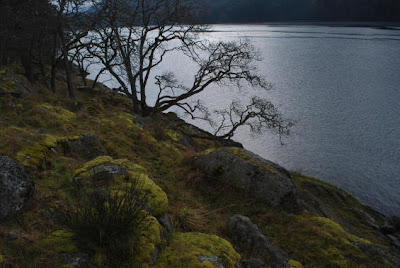If I take the right-hand trail at Burgoyne Bay it leads me along the mountainside at the foot of Mt. Maxwell. Its sandstone and conglomerate cliffs are hard to see when I look up the steep slope through the trees. Below, the ocean surface at the base of the mountain glitters through the solemn ranks of tree trunks. To emphasize my littleness in this giant landscape, large boulders ( some as big as houses) rest above me. They brace their feet deeply among the roots, with their heads raised bare amid the tree tops. All is grave and silent as I walk briskly by, trying not to heed a sense of being inspected, weighed, and found wanting.
At the end of the trail I reach a more open space; grass, moss covered rocks, Garry oaks, and the ocean which flashes in the sun or darkens again as a cloud brings a quick shower. Open sky at last! I begin to photograph a world that seems more made for me and my kind. From here I can see the cliffs above the tree tops catching scarves of cloud. They are a little less threatening from this angle and I feel the oppressive atmosphere of the trail behind me dissipate. I walk down a steep bank and out onto a smooth granite point.
Granite: white and grey with little black dots, hard as hard, here, below a thousand feet of sedimentary layers. It must form the floor of the deep inlet, with only this thin layer of steep shoreline showing that it underlies all those towering cliffs. The open light has fooled me: this steep shore is older still by countless millions of years and I am a little fly that crawls upon its face for an instant and is gone. I begin to make images of this eternal place. The glacier smoothed form I stand on, the black boulder at the tide line that, like me, has come from somewhere else and will be ground down and turned to sand while the granite will gain only another wrinkle.
This feeling of insignificance, of being a mere sparkle of light, a grain in the sands of time, is hard to shake. Yet, it is my photographing and my sense of relatedness to all this that brings me through to another place of understanding. There is no judgement anywhere here, no being found wanting. The key lies in my feeling for this landscape. I feel empathy for these trees, these beetling cliffs and giant boulders. Who is to say they do not grasp that with fierce intensity. A little flash that lights them up and says “ I see you. I make your image with reverence and care. We are in relationship, you and I.”
.jpg)

















